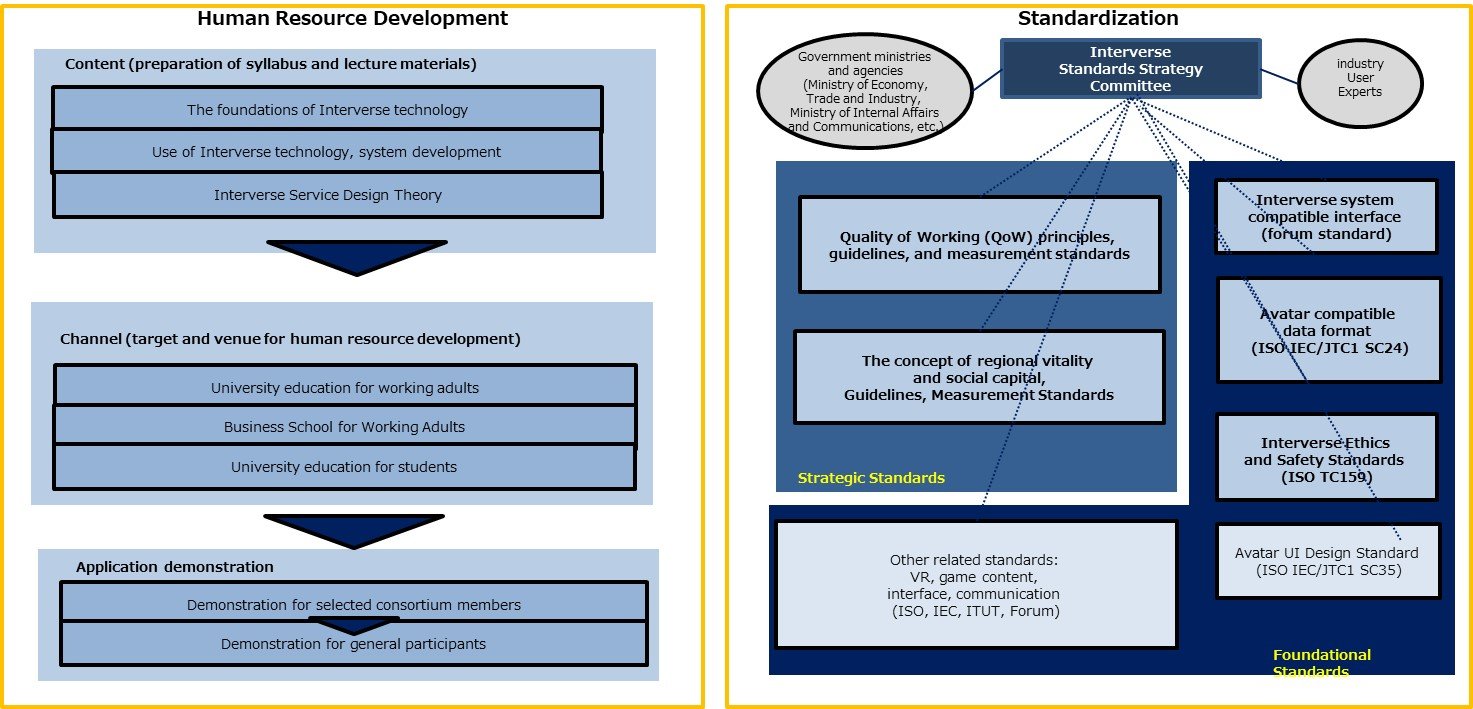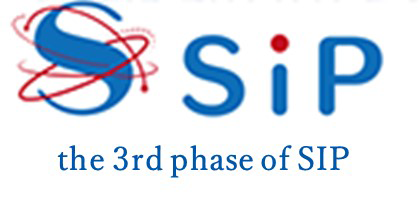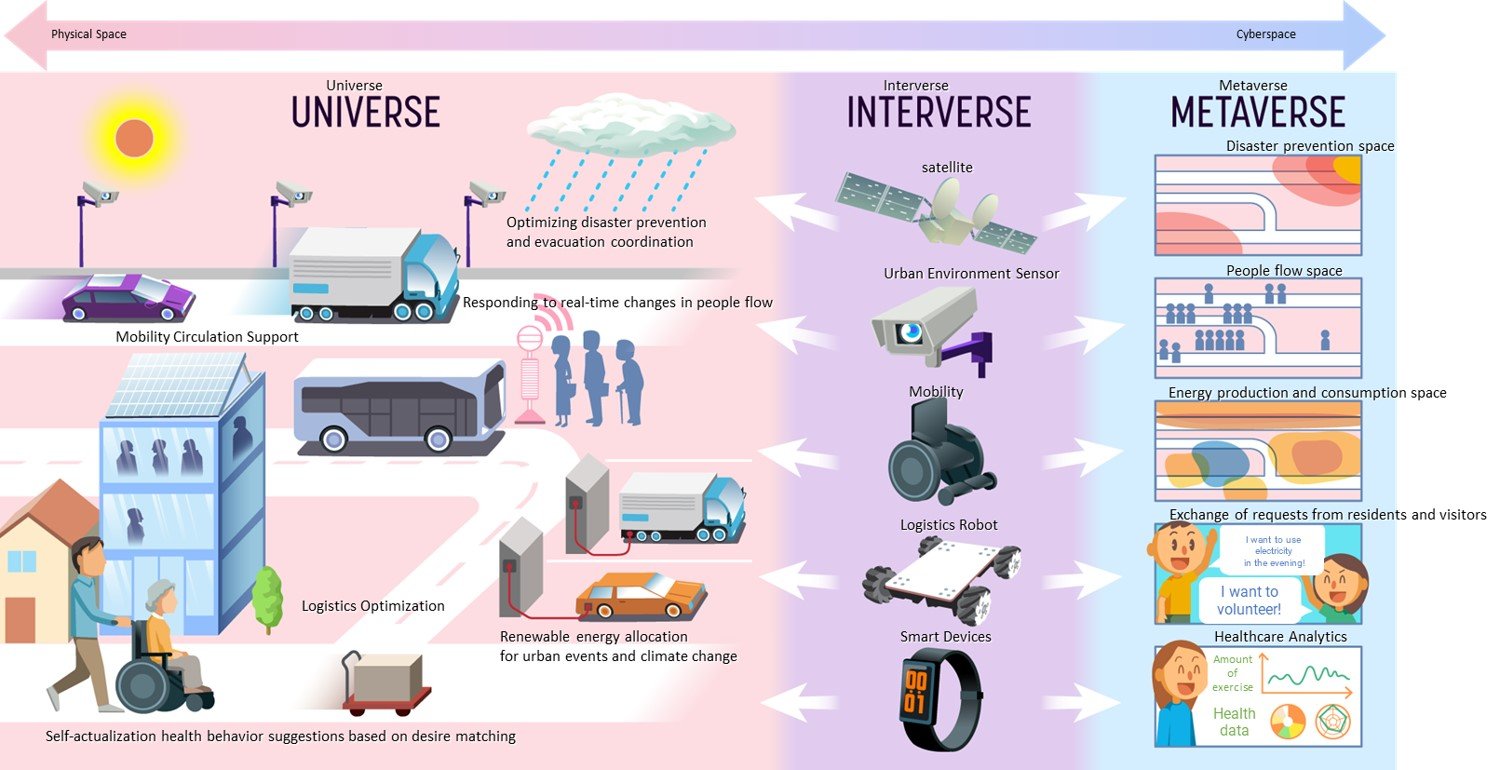In the third phase of SIP, we will not only develop technology, but also work on a wide range of issues from human resource development to business development.
Another characteristic of the virtual economy is that the spatial scale of social implementation differs greatly between human-centered services such as healthcare and offices and city-centered services such as urban development and mobility.
Depending on the difference in spatial scale, the methods of data acquisition and analysis, as well as the methods of data utilization (e.g., providing feedback to people, simulating people flow, etc.) also differ greatly.
Therefore, in this project, we will effectively advance social implementation by dividing the subprojects according to scale.
Subproject A will be "Physical Interverse technology" at the human scale (a few meters), and Subproject B will be "Smart City utilizing Interverse" at the city scale (a few kilometers or more).
On the other hand, common issues are expected regardless of the scale of social implementation (human level, city level), and two projects, "Interverse service infrastructure" and "Human resource development to support the virtual economy", will be implemented as Subproject C and Subproject D, respectively.
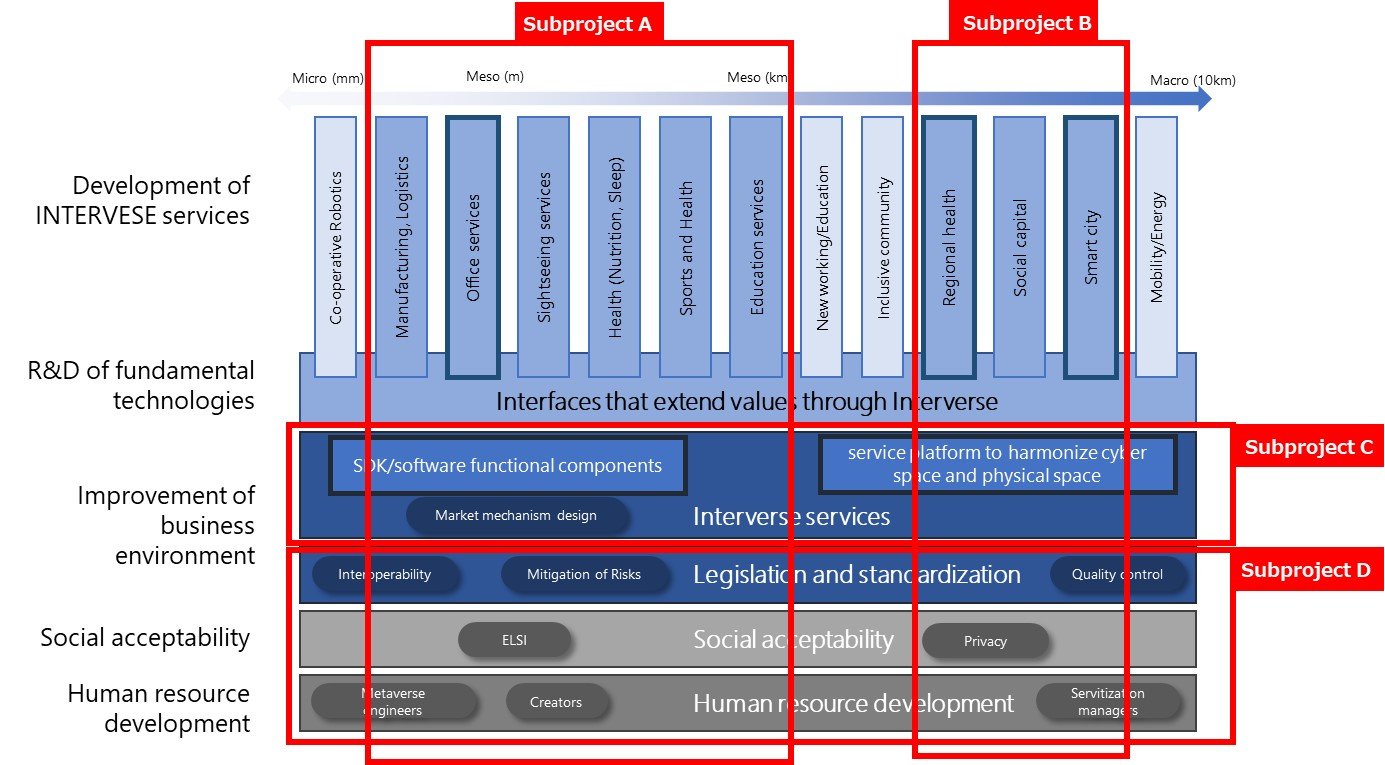
Subproject A: Physical Interverse technology
This subproject will examine rules and standardization measures for expanding the virtual economy, identify and address ELSI-related issues, and mitigate risks associated with Physical Interverse Technology (e.g., biosafety, addictiveness).
It will also involve the development of proprioception-sharing technology, haptics technology, and atmosphere transmission technology. Furthermore, these technologies will be implemented in various use cases, including maintenance, logistics, office work, healthcare, and communication services.
R&D Themes
| a-1 Research on proprioceptive data sharing technology | ・Establishment of technologies related to input/output technology of proprioception of the body, experience synthesis, and analysis and presentation of proprioceptive secondary data,cooperation between various devices based on research and use cases, and proposal of standards to ensure safety and maintain international superiority |
|---|---|
| a-2 Research on haptics technology | ・Development of haptics technology ・Development of services utilizing haptics technology ・Establishment of the Digital Haptics Consortium ・Examination of digital surface hardware business model ・Development of human resources that connect physical and cyberspace sensibilities |
| a-3 Communication Technology Utilizing the Interverse | ・Demonstration for the introduction of services in offices and public spaces ・Creation of examples of DX services in offices and public spaces |
| a-4 Research and Implementation of Healthcare (Exercise, Rest, and Nutrition) Using the Interverse | ・Development of new services in the healthcare field using the Interverse ・Demonstration for the introduction of services in the healthcare field using the Interverse |
| a-5 Consideration of rules and standardization for the expansion of the virtual economy | ・Establishment of international standards for interoperability infrastructure standards that take advantage of Japan's strengths (avatar description format, content, Interverse, etc. from Japan) and strategic standards that contribute to market expansion of use cases ・Development of SDKs to ensure compatibility between formats originating in Japan and major international platforms |
| a-6 Identification of issues related to ELSI and countermeasures | ・Examine ELSI and implement measures as a method of practicing ELSI and RRI. |
| a-7 Risk Reduction in the Interverse | ・Formulation of safety guidelines for Interverse-related businesses ・Analysis system for slanderers and flaming participants using psychological characteristics ・Behavior modification technology to prevent behavior related to slander and flaming ・Cyberspace dependency analysis system using psychoanalysis technology |

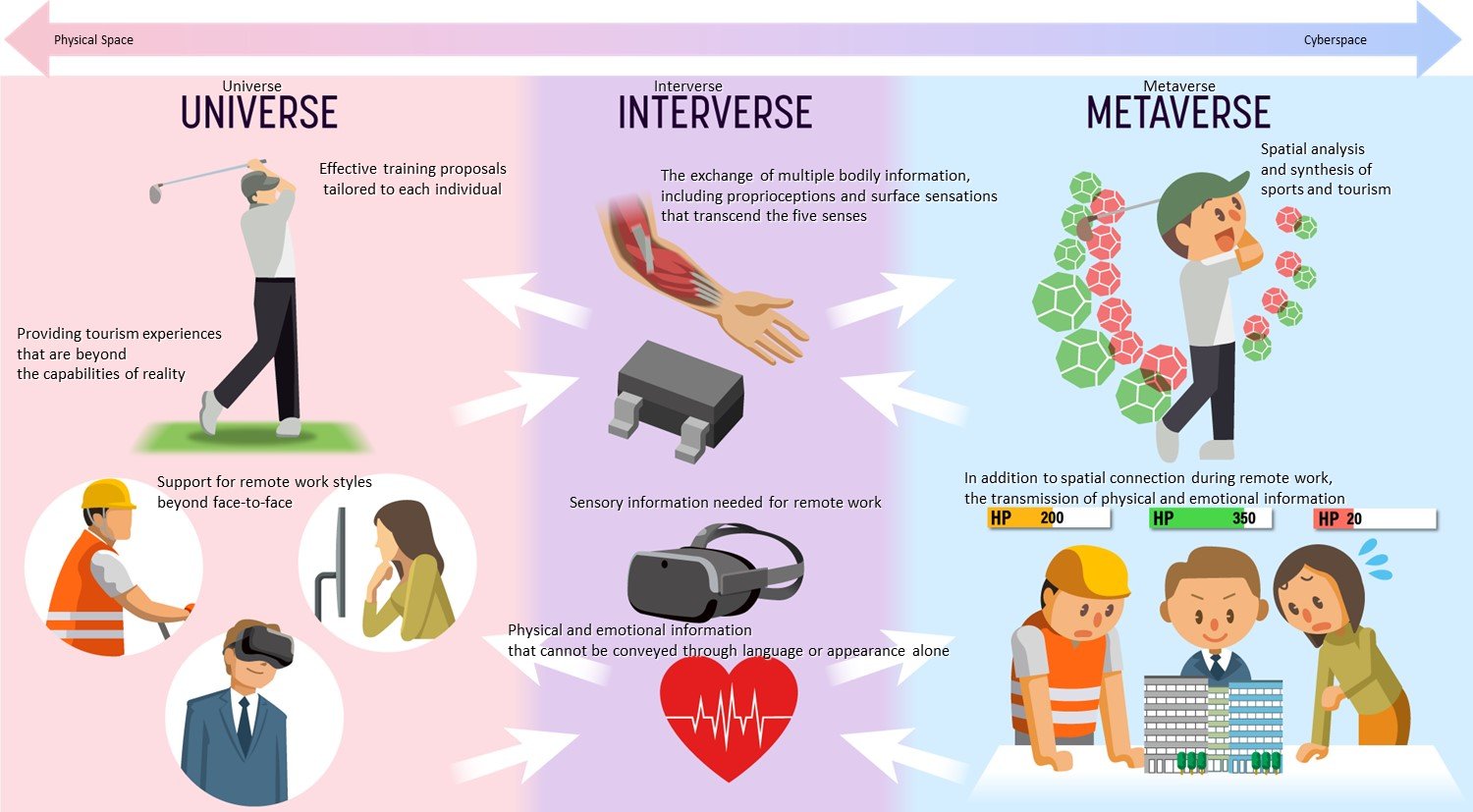
Subproject B: Smart City utilizing Interverse
Subproject B will introduce an Interverse approach that can eliminate spatial constraints on working styles in order to address various issues resulting from labor force imbalances between rural and urban areas, and will work to revitalize local communities.
Subproject B will also work to revitalize local areas and create new services and businesses through town development that breaks away from traditional uniform, impersonal town development and realizes the well-being of each individual by using an Interverse approach that emphasizes people's behavior and emotions, responding to diverse needs.
R&D Themes
|
b-1 Design and implementation of pioneering implementation ecosystems for the virtual economy, such as digital twins (smart cities) |
・ Development of digital twin enterprise architecture for smart cities and standardization of important specifications |
|
b-2 Research and Implementation of Digital Twins in Individual Use Cases in Healthcare |
・Medical and health fields: Handle sensitive personal information accurately and safely according to the purpose of use |
|
b-3 Research and implementation of digital twin technology for use in creating urban attractiveness |
・ Examination of digital twin technology for emotion-based spatial design and behavior change, and establishment of measures for physical/cyberspace collaboration |
Subproject C: Interverse service infrastructure
Subproject C will conduct research and development of SDKs and software functional components, as well as 3D digital general-purpose description and architecture technologies that will continually connect things and information.
Subproject C will also consider market mechanism design for the Virtual Ecosystem.
R&D Themes
|
c-1 Development of SDK and Software Functional Components |
・Research for seamless information linkage between physical space and cyberspace |
|
c-2 Development of a General-Purpose Platform for Dynamic Cyber/Physical Collaboration |
・Social implementation of a standard platform for cyber/physical collaboration that supports multiple applications |
|
c-3 Design of Market Mechanisms for the Virtual Ecosystem |
・Research on technology to support the Interverse community by applying economic models |

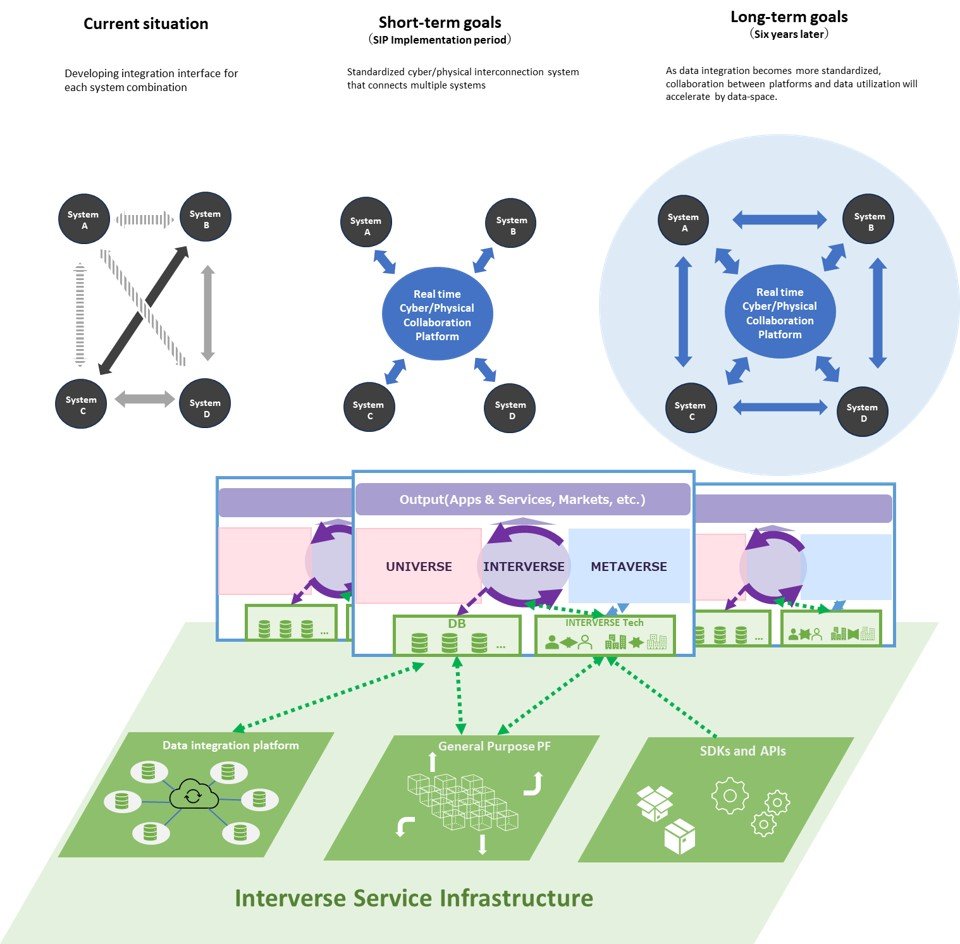
Subproject D: Human resource development to support the virtual economy
The human resources needed according to expanding the virtual economy are not only XR creators (training curriculum and certification) and engineers, but also people who can design/develop technology for the Interverse, and people who can design collaborations with other fields such as mobility and energy.
In addition, subproject D aims to develop management personnel who can develop Interverse services and commercialize them, as well as personnel in intellectual property, finance, etc. related to the Interverse, and people who can understand technology as law or in local and government roles.
R&D Themes
| d-1 Virtual Economy Human Resource Development | ・Development of virtual economy education standards ・Development and discovery of human resources for the use of the virtual economy |
|---|

